The above photograph is 'Dusk at Ravenglass'
Principles of Denture Cosmetics
Welcome to the Services page which is dedicated to helping you to assimilate the principles of Denture Cosmetics. Dentures comprise of the teeth, the base and the manufacturing technique. This section is aimed at helping you to understand what goes into making and fitting a set of dentures and the aftercare involved.
Tooth Manufacturer and Shade Selection
Patients expectations vary widely from the exhilarating brilliant wide white tooth smile we see from the tooth bleaching (whitening) fraternity to the clients requiring dentures utilizing the same high quality teeth they purchased from 20plus years ago. However, I must say trends do change and today we see the mature client purchasing lighter shades in Vivadent PE selection than they previously chose.
Why is this? One reason I feel is a a change of attitudes towards smoking where natural teeth of smokers took on a yellowish appearance.This together with the modern approach of Oral Care natural teeth are being nurtured with tender loving care.
It is therefore no wonder that the mature age group of the family unit are not being cast out with having yellow teeth.
Indeed denture teeth shades I would have thought were common place 20years ago are considered as 'too dirty' in todays modern hygienic thinking world, with yellowy teeth a 'No No'.
I have always considered the Vivadent from Ivoclar and Enigma from Schottlander as being the tip of the iceberg when cosmetics are considered. The True Natural Reproduction of a them, copy to a large degree the developing natural tooths internal structures shape of dentine and enamel structures to provide a light reflectiveness identical to natural teeth.
Mother of Pearl can easily be compared to the the effect the denture tooth has on light on the rebound from its surface. Light reflecting from the centre of the tooth being more important than from the tooth's surface. This providing a three dimensional effect.
Budget priced dentures with lesser quality denture teeth suffer tremendously from inperfections in aesthetic requirements. The symptoms of which arrise following the fitting process when patients return requesting spaces between the teeth and requesting the teeth be twisted to reduce the straight boredom. Whereas with quality teeth the teeth can be straight with the light being reflected within the tooth in diverging directions. Questioning patients with such requests would probably reveal that their own teeth were straight and true! Then why do they want their artificial teeth spacing and twisting?
Tooth Width & Length
Many authorities have proclaimed measurements to ascertain the correctness in selection of the front denture teeth. Shape of the face, feminine, masculine. Fig 4 illustrates a technique of determining the size in length and width of the front upper central incisor teeth.
To determine central incisor length the horizontal black line being placed on the hair line and the base of the chin being measured against the corresponding lower white line.
The central incisor width is determined by placing the vertical black line against the zygoma and reading off the corresponding white on the other side of the face. These two measurements are then converted into millimetres and the appropriote teeth selected.
Ultimately, the decision is with the client with guidance from Experts such as Gerber. Their decision is paramount in the process. Any Incorrectness in tooth size and position will invariably result in the client not being confident in social company and usually result in endless return visits requesting alterations. Private Quality teeth are built up in laminates and are therefore unsuitable for trimming and shortening. Any alteration from the manufacturers mould shape produces surface stress between the acrylic/composite internal structures. Unfortuantely this in combinations with the bleaching effect from denture cleaners and boiling water(which is not recommended) not only damages the joints internally but also creates stress and fractures between the acrylic base and tooth surfaces
The above three illustrations indicate how the base of the nose shape influences the plane of the incisal biting surface and the resulting symmetry to the rest of the face.
Facial can be classified as generally Square, Tappering and Ovoid. And then again size is width and height are important factors which we determine by comparing previous dentures and measuring devices as illusrteated on the right of this page.
Tooth Surface form
Possibly as neglected in cosmetics and in many instances can impart a degree of masculine or feminine form into the equation. Peoples faces viewed from the side show significnt genetic traits and is readily seen in relatives in family photographs.
Placing the teeth outside these basic principles of Basic Symmetry can result in clients puzzled about their appearance.
Fig 10 Keeping the symmetry parallel
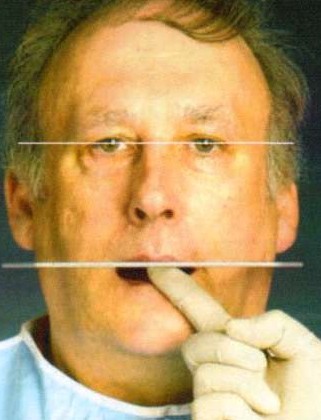
The above illustration is a plane which helps to position the front teeth parallet to the eyes. As you will observe the nose and ear features are not 100% identical. You will observe the right ear is higher than the left ear and the left nostril is smaller in development. Small facial features may have tooth development significance to the denture anterior tooth position. Great care is required in determining this position. If it is too high up the patient will show no teeth at rest and too low down will look as though they are smiling all the time. Appearance is important. It is the clients 'confidence'. An operator can loose all credability if the patients leaves the clinic grinning like a cheshire cat.
Either position can have seriously affect on their speech with deviation in pronouncement and confidence.
Upper and Lower Jaw Relationship
The Alma Gauge is used to measure vertically the distance between the upper and lower jaws. It determines and measures the freeway space, the bite relationship and relaxed relationship in millimetres. These are then recorded for future reference.
These are crucial measurements in orfer to prevent the patient being overclosed or over open.
Overclosed causing the joints near the ear to be squashed whilst the chin is too close to the nose. Usually associated with badly worn teeth.
Overopen stretches the muscles connecting the sides of the lower jaw to the temple area of the head. The presenting symptoms being headaches at the temples and feeling uncomfortable. They will also complain about not having enough space between their upper and lower back teeth preventing them from loading sufficient food between the molar teeth. Swallowing can also form a problem with many patients finding they are unable to form a seal between their upper and lower lips. This being a basic requirement for swallowing.
Many operators attempt to open the vertical face height in an attempt to remove the loose flabby skin under the lower jaw or stretch the skin folds associated with ageing.The instrument in fig 9 is a very important measuring device and is used to record the patients face height. It can be used to record the patient's jaw relationship at rest as well as relaxed. I denote these as the VOFH and the VRFH. They are the Vertical Occluded Face Height and the Vertical Relaxed Face Height. The latter showing an increased dimension of at least 5millimetres over the former.
I do not recommend increasing this dimension as it interferes with the fixed mechanical featres of the musco-skeletal structure which is nothing to do with cosmetics. The capsular ligament and synovial cartilage can be damaged which may cause long term damage to the joints.
Fig 9. Willis Gauge: Determining The Vertical Face Heights.
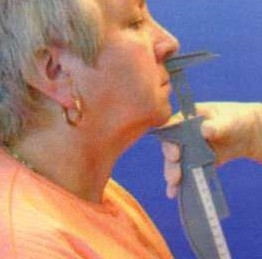
Fig 1 Determining Central Incisor mould using the facial form.

Facial form can be classified as generally Square, Tappering and Ovoid. And then again size in width and height are important factors which we determine by comparing previous dentures and measuring devices as illustrated in fig 1 above.
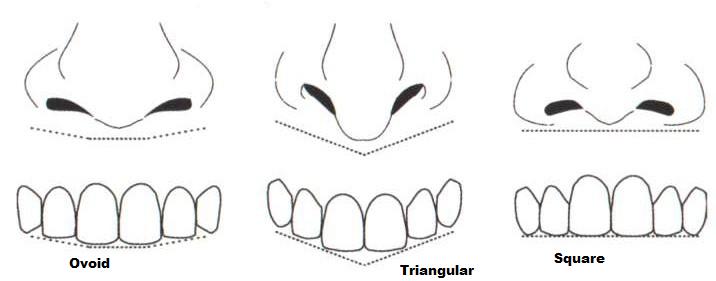
The persons profile from the side indicates to some degree what curvature there should be on the front facial surface of the incisor teeth. Again Tappering is indicated by triangular with straight and proclining positions. Ovoid indicates a marked roundness to the facial surface and indicating harmony with the facial form.The following instrument records the nose width and relates to the operator the overall width of the six front teeth. The resulting reference number relates to various moulds that include youthful, medium and mature moulds.
Fig 3 Determining the overall width of the front teeth relative to the nose width.
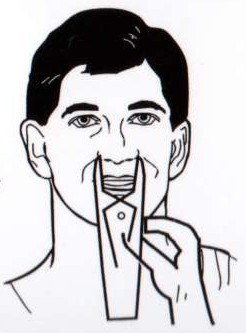
Fig 4 Determining the Central Incisor size relative to the face size
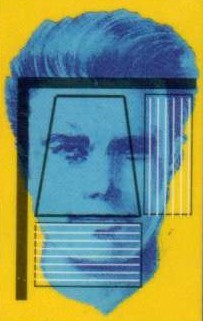
Fig 5 Determining the position of the front teeth relative to the nose.
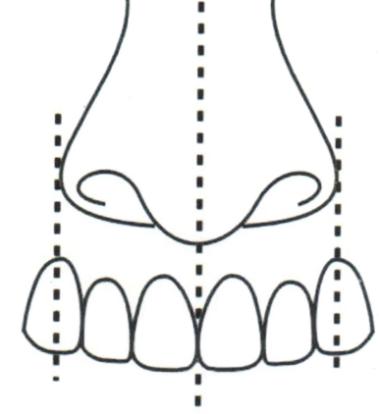
Fig 6 Determing Incisor facial curvature
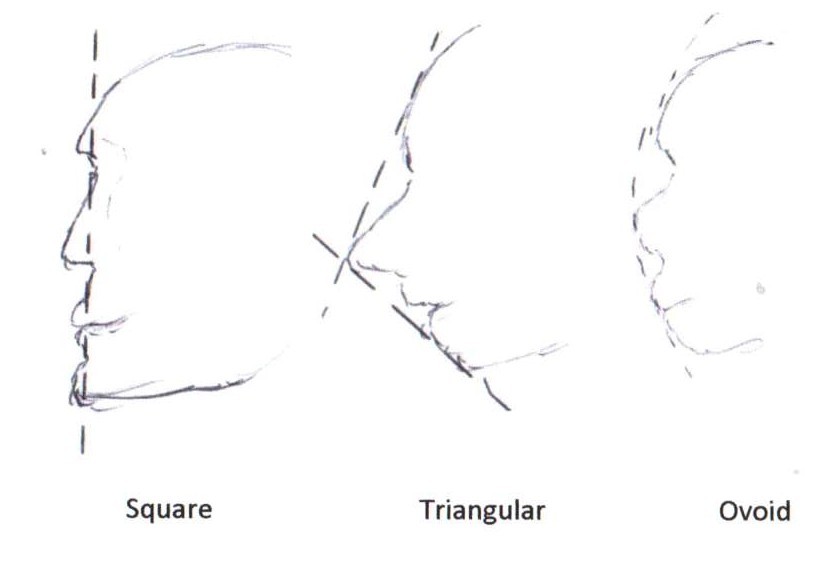
The above categories generally correspond to the Facial shape. Ovoid shaped profiles geneally have reclined arched anteriors whilst Square profiles people tend flat surfaced teeth. Triangular profiles can be straight but end to generally procline forward.
Tooth Placement
The operator and technician should be careful not to pronounce the upper front teeth beyond approximately 7mm. The result will be a stretchning of the lips and the inability to place the tongue to the back of the mouth to remove food. Smiling can also be affected producubg a Wallace and Grommit with the teeth sticking out pronouncely.
Incompetent lips(lips that dont close in the relaxed state when the teeth are biting) make it difficult to swallow as the person is unable to form an anterior oral deal. The above situation is undertaken usually at the request of the patients demands to use the dentures to revigorate their youthful appearance.
Ageing with it brings a lack of facial muscle tone. This is often apparant with the long 'miserable face appearance'.
A lengthening or dropping of the upper lip creates a lack of front tooth appearance. Again this situation needs to be rectified with soft tissue support using the pink denture base supportive area. Rather than proclining or dropping the teeth.
Fig7 Determining Front teeth position relative to anatomical features
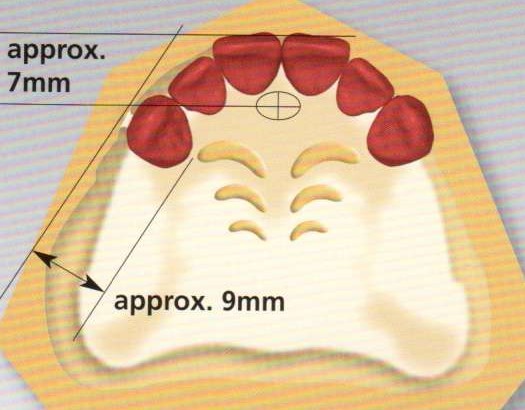
Fig 8 Anatomocal features relative to the lower denture
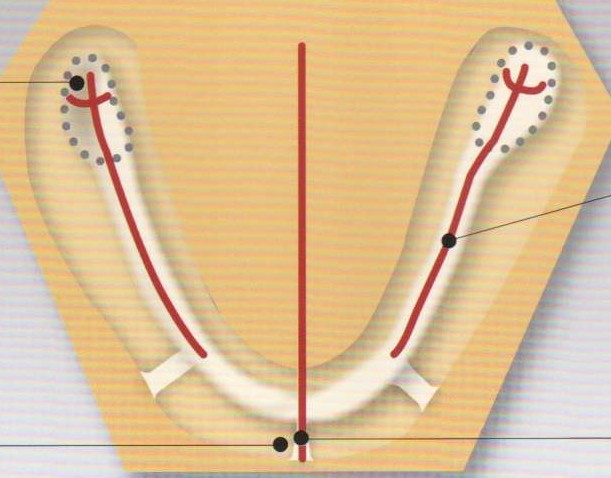
The lower denture is likewise designed around strict anatomical points as is illustrated above. However the design features are too long winded to discuss and depens upon the success of previous dentures and the state of the residing anatomical structures.
Tooth placement is restricted in many instances as the retentive features of the remaining redge are generally somewhat limited. This is due to resorption, duration of edentulousness, age, medical status.
This is why implants are considered to be an alternative to a moving lower dentures.